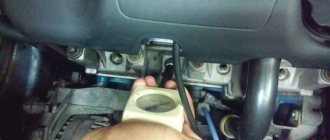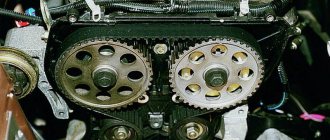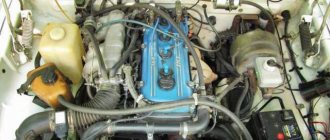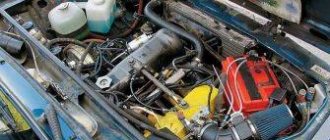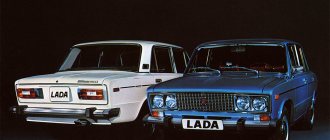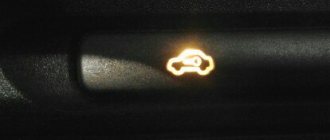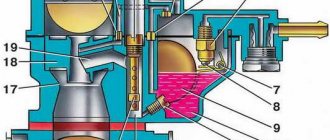The carburetor on the nine is a capricious thing. Sometimes he presents extremely unpleasant surprises to his owners. In general, it doesn’t even matter whether it’s a Solex or a standard VAZ carburetor. Difficulties arise even with expensive and modern ones. Drivers often notice that on a VAZ 2109 car the carburetor shoots.
What is this connected with? And does that mean you need it urgently? Carburetor repair may not be necessary if you find the causes of the malfunction in time and eliminate them by replacing worn parts. Let's broaden our horizons, gentlemen, car enthusiasts. VAZ cars sometimes delight us with their reliability, but still, let’s be realistic. The domestic carburetor does not last forever, and can also fail. Which often happens. Sometimes it is enough to replace the filters; in other cases, you need to completely disassemble the VAZ 2109 carburetor.
When you disassemble a VAZ 2109 carburetor, faults become visible to the naked eye. After this, you may need it. Well-done cleaning and flushing of the VAZ 2109 carburetor, done on time, can seriously extend the life of the carburetor on your car. The correct one prevents many. Taking good care of the carburetor will extend its service life, as well as the life expectancy of the car itself. Don't forget that this depends on many factors, including the quality of the fuel.
What is it and how to deal with it? If dips appear when accelerating, this may be caused, for example, by problems with the accelerator pump. Check for air leaks under the carburetor of your car. Check the air filter; clogging can cause many problems in the carburetor.
And when it is carried out, it needs to be checked. When you are convinced that everything indicated is in order and the gas line is working properly, you can continue the diagnostics. Next on the list of possible candidates is the accelerator pump.
This should also be checked. The carburetor damper may not open completely when the choke is turned off. VAZ carburetors are a thin mechanism. Sometimes people simply can’t stand it and buy a new one without understanding the reasons for the malfunction that led to failure. In general, in fact, failure of the VAZ 2109 carburetor when pressing the gas pedal is one of the very common symptoms on Nines. For convenience, we invite you to watch a video where a specialist demonstrates how to solve the problem of starting failure: Another video recorded by Nail Poroshin about failures when pressing the gas pedal: Check the fuel level.
This could also be one of the reasons: Using a gas pump, you pump up gasoline. Remove the cover from the carburetor. Measure the level. It should not exceed 26 mm.
We check the gap between the floats and the gasket with the cover upside down, it is 1 mm. After this, the tightness of the needle valve is checked. If all this does not result and you cannot determine the reason, we advise you to take the car to a car service center.
A fairly common problem with carburetor cars is the characteristic popping noise in the carburetor. The malfunction may occur when the engine starts and fires into the carburetor, as well as during operation of the internal combustion engine after the power unit has been started. At the very beginning, we note that experts consider the main reasons to be a severe depletion of the fuel-air mixture, ignition timing, or malfunctions of the gas distribution mechanism associated with incorrectly set phases.
As for the CIS, most carburetor cars on the roads are Russian-made models. Next, we will look at problems when a VAZ engine shoots into the carburetor, why a 406 engine shoots into the carburetor, and also talk about how to detect and fix such malfunctions with your own hands.
Read in this article
Causes of “shots”, “pops” and flashes in the carburetor
- High voltage cables are not connected correctly. In this case, the spark will not occur during compression, but on other strokes, since the sequence of operation of the engine cylinders is not followed. It happens that the engine appears periodically. In this case, the solution to the problem is to reinstall the wires from the spark plugs into the distributor cover. You need to start from the installation mark counterclockwise in the following order: 1-3-4-2.
- Late ignition. Late ignition is when the spark jumps too late on the compression stroke, and combustion of the working mixture occurs throughout the entire power stroke, and not during compression. When the intake valves open, the fuel mixture is still burning and ignites a new portion.
- Faulty ignition distributor. This problem can lead to problems with the operation of the motor in all modes. It also happens that “shooting” is provoked by weak fastening of the holder. Here it is important to understand the cause of the problem in time, and also replace the distributor with a new and working one.
- The problem is in the ignition system switch. In this case, you just need to replace the switch with a new one. Repairing it is pointless and expensive; it is better to buy a new one and install it.
- The timing belt has moved 1-2 teeth. Often this problem occurs when changing the motor. The solution requires reinstalling the timing belt. This can be done if you follow the instructions, but it is better, of course, to seek help from specialists.
- Lean fuel system. If such a system enters the engine, then flashes and sparks are natural. The solution to the problem is to check the fuel fluid in the float chamber. You also need to check the cleanliness of the air and fuel jets. You can also clean the carburetor with a special solution. If the problem persists, you need to check whether the accelerator pump is working properly.
- The intake valve is burnt out. If the plate is not pressed well against the valve, sparks will appear. It is quite possible that it burned out or sagged over time. Using a compression gauge you can identify the malfunction. If there is a problem, you need to remove the cylinder head and replace it with a new one.
- Small recesses in the valve device. It happens that when repairing a motor, the recesses are made too small so that it creates less noise during operation. However, because of this, the plates do not fit tightly to the seats, which leads to shots in the carburetor. To eliminate the malfunction, you need to check and adjust the gaps.
Doesn't start in winter
The problems described above mainly occur in the summer, but there are also a number of breakdowns in which the VAZ stops starting in the cold. Here the main reason remains frost. Because of it, in particular, the lubricant thickens, which prevents the crankshaft from rotating normally. A simple trick will help relieve the load - just when you start the engine, squeeze the clutch all the way.
Trouble also arises due to decreased compression in the cylinders. A similar problem is typical for Zhiguli cars with high mileage. This requires a thorough overhaul of the engine under stationary conditions with the obligatory replacement of rings and piston seals.
When you need to at least make it to the garage or service station, do this:
- turn out the spark plugs;
- pour no more than 5 cubic centimeters of oil (regular motor oil) into the combustion chambers;
- crank the starter several times by hand;
- put the spark plugs on and start.
If the engine is hopelessly frozen, you will have to use starting fluid - this composition is easy to buy in specialized stores. The substance must be poured directly into the carburetor. To gain access there, unscrew the cap on the air filter.
Sometimes the problem is caused by a weak spark on the spark plugs. On hot summer days, this circumstance does not interfere with starting the engine, but in cold weather the situation changes radically. The problem is created due to poor contact at the terminals of the ignition coil and distributor. Disconnect them, clean them from oxides and dirt.
General manifestation of the malfunction
Popping noises in the carburetor may appear under the following circumstances:
- after engine repair;
- there was an accident or a pothole on the road;
- tuning or simply adjustment of the carburetor was carried out;
- the car has high mileage.
In this case, a malfunction may occur in the following cases:
- when you press hard on the gas pedal;
- after parking, with a cold engine;
- on the go under load;
- when trying to start the engine.
Depending on the reason that caused the carburetor to shoot, popping noises can appear either abruptly or gradually, increasing in intensity daily. Operating a car when the engine sneezes into the carburetor, in addition to discomfort for the driver, can lead to the need for major engine repairs.
High voltage wires
When carrying out repairs affecting the ignition system, the high-voltage wires may be connected incorrectly. In this case, the spark will not occur in time with the compression cycle, resulting in popping sounds. Even if the engine starts, its power is not enough to move the car.
To diagnose a malfunction, you should check the connection of the wires from the spark plugs to the distributor. You should push off from the mark located on the cover. The connection of high-voltage wires must correspond to the car model. For example, the location of high-voltage wires in the VAZ 2109 is shown below.
Correct connection of high-voltage wires VAZ 2109
Shoots at the carburetor - causes and solutions
A lot of worries, nerves, and sleepless nights are caused to car owners by the situation when the carburetor of their car begins to emit loud pops, similar to gunshots. At the same time, the car jerks, sneezes, and the engine runs unsteadily. This article explains why this happens and how to eliminate it. So, why does the carburetor shoot?
The most common problems with the carburetor
If you have been driving a VAZ 2109 for a long time, then you have probably already encountered a similar problem when the car starts perfectly if there is gasoline in the tank, but if you forgot to refuel on time and reached the pump at zero, then problems with ignition may arise. Also, after a “hunger strike,” the car may simultaneously make unusual sounds that come from the carburetor.
There may be several reasons for such a breakdown:
- long idle time of VAZ 2109 (more than 1.5 years);
- the ignition is set crookedly (not according to the marks);
- rust in the carburetor (iron oxide molecules flake off in microscopic compounds and enter the thin outlet, and this happens regularly and cleaning helps temporarily);
- clogged fuel supply filter (poor quality fuel);
- clogged jets or fuel needle valve of the float chamber cover.
When the carburetor starts to “sneeze”, problems with the float and jets may also appear. This is accompanied by poor acceleration, or difficult starting, or all combined. In this case, the engine can run at idle speed, but if you try to give high speed it will stall. Most often this happens due to incorrect float settings or the appearance of rust on the parts of the VAZ 2109 carburetor.
Let's start with rust. You can detect it in several ways:
- A rusty mass similar to plasticine at the bottom of the float chamber;
- Torn jet ring;
- Normal hard rust on the inside of the float chamber.
All this leads to corrosive material entering the nozzle when the car is moving, and it simply becomes clogged. In this case, it is necessary to remove the rust, then rinse the carburetor with gasoline or another cleaning solution, replace the rusted rings, blow out the jets and the car will be ready for work.
A small amount of gasoline in the tank also has a negative effect, for example, when driving a car with a frequently burning “red light,” the float may jam and the fuel supply will stop altogether, or, on the contrary, consumption will increase several times. In this case, the best option would be to tow the car to the nearest box and adjust the float.
The float may go astray in other cases. This also leads to a loss of vehicle power and increased fuel consumption. It is best to contact an injector for quality adjustments. But you can cope on your own. As soon as you notice that your car begins to consume more fuel, you know that it is the carburetor.
Featured Posts
Hurik
- Newbie
- Users
- 1
- 19 publications
- Car make: VAZ21063
- From:Donetsk
Hello. I have a VAZ21063 with a contact ignition Solex carburetor, the car started shooting at the carburetor when the 2-chamber was opened. I myself understand the ignition and the carburetor. I washed, blew out the carburetor, rebuilt the trampler, adjusted the valves, set the ignition, checked the compression to 10 in all, changed the spark plugs and wires, none of the above helped. Help who can.
Susanin33
- local
- VIP Member
- 66
- 1,503 publications
- Car make: VAZ – 21093
- From: Russia, Vladimir
Help who can.
lean mixture, early ignition, insufficient closing of the intake valve
Protva
- Mechanic
- VIP Member
- 356
- 6,001 publications
- Car make:Chevrolet Lanos SX
- From: south Mos. region
I'll add a blown gasket between the manifold and the head.
zhigalo
- Advanced
- Advanced Members
- 3
- 263 publications
- Car make: VAZ 2107
- From:Kostanay
Did you set the distributor according to the marks?
Hurik
- Newbie
- Users
- 1
- 19 publications
- Car make: VAZ21063
- From:Donetsk
lean mixture, early ignition, insufficient closing of the intake valve
I changed the 2-carb plus adjusted it, set the ignition earlier and later, checked the valves twice, measured the compression at 10 in all. Nothing has changed.
Hurik
- Newbie
- Users
- 1
- 19 publications
- Car make: VAZ21063
- From:Donetsk
I'll add a blown gasket between the manifold and the head.
the engine runs fine at XX, the tasol does not go away, the spark plugs c1-4 are red, the engine does not run louder. The car began to shoot at the carburetor when opening the 2nd chamber. What is the problem with the gasket between the manifold and the head????
Hurik
- Newbie
- Users
- 1
- 19 publications
- Car make: VAZ21063
- From:Donetsk
Did you set the distributor according to the marks?
Yes, according to the marks.
Susanin33
- local
- VIP Member
- 66
- 1,503 publications
- Car make: VAZ – 21093
- From: Russia, Vladimir
Yes, according to the marks.
vacuum advancer
Hurik
- Newbie
- Users
- 1
- 19 publications
- Car make: VAZ21063
- From:Donetsk
vacuum advancer
The vacuum corrector was checked to be normal, I even tried turning it off, no change.
Protva
- Mechanic
- VIP Member
- 356
- 6,001 publications
- Car make:Chevrolet Lanos SX
- From: south Mos. region
spark plugs s1-4 red
It is better to replace spark plugs with red insulator. Over time, they begin to break through to ground.
Sorrel
- Advanced
- Advanced Members
- 29
- 365 publications
- Car make: VAZ 21093
- From:Russia
I’ll get into the conversation, try to pull out the choke a little, and you’ll go for a ride. It’s quite possible that he’ll stop shooting, if he stops I’ll tell you what’s going on next))) If he continues to shoot, I won’t be able to do anything to help. And even if the car is warmed up, still open the choke a little while driving.
Hurik
- Newbie
- Users
- 1
- 19 publications
- Car make: VAZ21063
- From:Donetsk
I’ll get into the conversation, try to pull out the choke a little, and you’ll go for a ride. It’s quite possible that he’ll stop shooting, if he stops I’ll tell you what’s going on next))) If he continues to shoot, I won’t be able to do anything to help. And even if the car is warmed up, still open the choke a little while driving.
The choke really helps and the engine stops firing! what’s the matter??? share your guesses, is it really possible that the carb is fucking brains....?
Protva
- Mechanic
- VIP Member
- 356
- 6,001 publications
- Car make:Chevrolet Lanos SX
- From: south Mos. region
It's also interesting to know what the reason is. I can only assume that somewhere... I won’t guess. Waiting for Sorrel
.
Hurik
- Newbie
- Users
- 1
- 19 publications
- Car make: VAZ21063
- From:Donetsk
It is better to replace spark plugs with red insulator. Over time, they begin to break through to ground.
The spark plugs have nothing to do with it, I changed the same canoe.
Sorrel
- Advanced
- Advanced Members
- 29
- 365 publications
- Car make: VAZ 21093
- From:Russia
Do you have a temperature regulator? Today I personally encountered popping noises (in Moscow today it was -12), all this was due to the supply of Cold air, (I didn’t have a thermostat on the 9th) I installed it, the popping noises disappeared. So the problem with popping noises is that Pts gets into the carburetor. cold air. check the thermostat, maybe it hasn’t been working for a long time...
VAZochnik
- Newbie
- Users
- 0
- 9 publications
- Car make:VAZ 21061,VAZ 21074,VAZ 21124,
- From: Mordovia
If five carburetors have already been changed and there are no changes, then the problem is not with them (c).
In my opinion, you need to completely change the SZ distributor + coil. Take known good ones and see what changes. Start by replacing the coil; if that doesn’t help, change the distributor assembly.
I had a similar problem - that in the end it hurt - no one could explain. Some shouted that the capacitor on the distributor was broken, others that its bearing was jammed... It ended with the transition to BSZ. The troubles are over.
Motorist
- Advanced
- Advanced Members
- 17
- 375 publications
- Car make: VAZ 21074, Java 638.
- From: g. Pavlovo
In the winter, with the air cap turned off, my air pump would stall for the winter. You drive and drive, and suddenly the engine stalls. You wait for 10 minutes and you can go again. I turned the lid to winter time and that was it. And SZ has nothing to do with it. This is the same as trying to eliminate rear axle noise by changing the pump bearing.
n1ger
- Guru
- VIP Member
- 28
- 562 publications
- Car make:VAZik 21043
- From: Saldyukino
Idk... I drove around all winter with the switch turned off =)
and now the pan has been sawn apart =) it doesn’t seem to stall or fire...
although... there is... it happens... the scolex began to shoot (rarely, really, very rarely). I didn't notice this with ozone.
Hurik
- Newbie
- Users
- 1
- 19 publications
- Car make: VAZ21063
- From:Donetsk
Idk... I've been driving around all winter with the switch not turned =)
but now the pan has been sawn apart =) it doesn't seem to stall or fire...although... there is... it happens... the scolex began to shoot (rarely, really, very rarely). I didn't notice this with ozone.
What kind of Solex, and what kind of jets are they?
n1ger
- Guru
- VIP Member
- 28
- 562 publications
- Car make:VAZik 21043
- From: Saldyukino
Solex 83-51... rebuilt =D
top from 83 regular, bottom from 83-51. I bored out the diffusers to 2324. I don't remember the jets.
seems like this:
TZh1 107.5 VZh1 150
TZh2 115 VZh2 165
(I can’t find a standard repair kit for 21053-20 =((( )
I installed the current accelerator nose from the Niva and that’s it.
Hurik
- Newbie
- Users
- 1
- 19 publications
- Car make: VAZ21063
- From:Donetsk
Guys, does anyone have a Solex08 without modifications on the 11th engine, and with what jets? Otherwise I’m stuck... surf the forums, one has some tariffs for jets, another has different ones, huh.. you’ll understand which ones are needed. I have
GTZH 1.K-97.5 GTZH 2.K-97.5 GVZH 1.K165 GVZH 2.K125
Hurik
- Newbie
- Users
- 1
- 19 publications
- Car make: VAZ21063
- From:Donetsk
AU...... Is it really possible that 518 people who read the topic cannot answer the last question asked!!!!!!!!!!!
Radio technician
- Master
- VIP Member
- 578
- 2,185 publications
- Car make: VAZ 21053
- From:Ekaterinburg
What does carb have to do with it? The chain is ground off faster and the phases are delayed. This includes closing the intake valve during early ignition. They put it on early because the engine doesn't work (?).
Hurik
- Newbie
- Users
- 1
- 19 publications
- Car make: VAZ21063
- From:Donetsk
What does carb have to do with it? The chain is ground off faster and the phases are delayed. This includes closing the intake valve during early ignition. They put it on early because the engine doesn't work (?).
My friend, you didn’t understand me, the problem with shooting into the carb was solved by increasing the valve clearance. Now the problem is the following, I recently installed a Solex 08 since my native ozone has worn out in 21 years, the jets on the Solex are as follows
GTZh 1.K-97.5 GTZh 2.K-97.5 GVZh 1.K165 GVZh 2.K125, at xx the engine is like a clock, on the 1st chamber it runs great, but on the 2nd chamber the car becomes stupid, jerks and there is no acceleration. Carb soap was blowing through the effect 0. What's the matter? Maybe the level in the PC or the jets is not what it should be?
ivan65
- Newbie
- Users
- 0
- 4 publications
- Car make: VAZ 2107
- From: Rostov
It is necessary to adjust the fuel pump pusher (either it sticks out a little or is worn out, if it is worn out, replace it with a new one) and this will most likely help. As a rule, the malfunction is on the surface - you just need to think about it.
Why does the engine shoot into the carburetor: resulting in popping noises
A fairly common problem with carburetor cars is the characteristic popping noise in the carburetor. The malfunction may occur when the engine starts and fires into the carburetor, as well as during operation of the internal combustion engine after the power unit has been started. At the very beginning, we note that experts consider the main reasons to be a severe depletion of the fuel-air mixture, ignition timing, or malfunctions of the gas distribution mechanism associated with incorrectly set phases.
As for the CIS, most carburetor cars on the roads are Russian-made models. Next, we will look at problems when a VAZ engine shoots into the carburetor, why a 406 engine shoots into the carburetor, and also talk about how to detect and fix such malfunctions with your own hands.
Distributor
This unit is also capable of causing untimely and improper ignition of the fuel mixture in the engine cylinders. Malfunctions of the ignition distributor include breakdown of the cover, breakdown of the slider, and oxidation of the contacts of the explosive wires.
To determine whether the distributor is the cause of popping noises in the VAZ carburetor, install a known-good unit. If the lumbago disappears, then you need to diagnose the distributor and troubleshoot it. This is the only way to get rid of pops.
Mixture composition
If the engine is supplied with a too lean or rich mixture, then shooting is also possible. This situation may arise if the carburetor has been adjusted. Incorrect installation of the quality screw leads to incorrect preparation of the air-fuel mixture.
When operating on a lean mixture, the mixture burns slowly. When the intake valve opens, fuel continues to burn out. It ignites a new combustible mixture. Combustion occurs in the intake manifold and the engine shoots into the carburetor. At the same time, an increase in engine temperature is observed.
When working with an enriched mixture, black carbon deposits form on the electrodes. If there is enough plaque and a high temperature, it can ignite the air-fuel mixture at the wrong time. This causes the carburetor to pop as the intake valve is open at this time. This malfunction only appears when the engine is warm. Gradually the engine sneezes more and more often. A significant drop in power in this case is extremely rare.
For diagnosis, you should inspect the spark plugs. The presence of a white color indicates operation on a lean mixture. Black plaque, on the contrary, indicates over-enrichment.
To eliminate the malfunction, the carburetor should be inspected. If adjustment does not help, then flushing is required. You should also be careful about the fuel purchased at gas stations.
Inlet valve
A bent or burnt valve is unable to seal the combustion chamber from the carburetor. Loose pressure of the plate to the seat allows gases to break into the intake manifold. In some cases, the fresh air-fuel mixture ignites.
To diagnose the problem, you need to check the compression. If a cylinder is detected with a suspected combustion chamber leak, it is necessary to fill it with engine oil. This will prevent excessive wear of the cylinder-piston group or sticking of the piston rings. A cylinder with a damaged valve shows the same compression both with and without oil.
To eliminate the malfunction, it is necessary to dismantle the cylinder head and replace the valve. If the valve is bent, it is recommended to check the correct timing of the timing belt. Burnout of the valve with low mileage also requires searching for the cause of this breakdown.
If you have hydraulic boosters, you should also check their operation. Sticking of the hydraulic compensator leads to the same consequences as burnout of the valve. In this case, shooting into the carburetor may not be observed all the time, but during certain periods, for example, when the engine is cold or hot. Very often, car owners complain that they shoot when I start the engine.
Concurrent symptoms
As a rule, the situation is accompanied by a number of other signs:
- unstable operation of the internal combustion engine in idle mode;
- difficulty starting;
- loss of power and throttle response of the power unit;
- rapid overheating of the motor;
- increase in fuel consumption.
Note also that in such a situation the car accelerates poorly. When you press the accelerator pedal, jerks, dips, and delays appear. The car jerks a lot, especially in transition modes. The power plant does not so much work as “sneeze.”
Switch failure
Typically, a breakdown of the switch makes it impossible to start the engine, so popping noises will be observed when trying to start. To diagnose, just install a new device. If the motor stops firing, then the switch needs to be replaced or repaired. What to do depends on the type of breakdown and the capabilities of the car owner.
Very often this malfunction can be detected at an early stage. The engine speed begins to fluctuate, and when you sharply press the gas pedal, the car accelerates with dips in traction. Small popping noises are heard from the engine compartment.
The starter rotates, but there are no flashes
The next typical malfunction is the rotation of the starter in the complete absence of flashes. Here are the reasons why this could happen:
- broken timing belt. The first thing the owner of a VAZ 2106 should do when noticing the rotation of the starter without flashes is to check the integrity of the timing belt. It's simple: the starter rotates properly, but the torque is not transmitted to the crankshaft, since there is simply nothing to transmit it to, since the timing belt has broken (or has flown off the guides - this also happens if the belt is heavily worn and begins to sag). The solution is obvious: the timing belt will have to be changed;
The starter works, the engine starts and then stalls
In some situations, the car owner cannot start the engine of his “six” even if the starter is working properly. It looks like this: after turning the ignition key, the starter makes two or three turns, the engine “seizes”, but literally stalls a second later. This happens because of this:
- The fuel pump is not working properly. The situation is simple: very little fuel is supplied to the combustion chamber, and literally after one engine stroke the supply of the fuel mixture stops. There is only one way out: remove the pump, disassemble it and carefully inspect it for wear and mechanical damage. If the problem is really in it, change it;
- the fuel line is clogged. This is another reason why little fuel mixture enters the combustion chambers of the “six”. It's no secret that the quality of gasoline in our country leaves much to be desired. Modern gasoline contains a lot of foreign impurities, which are gradually deposited on a variety of surfaces - from the inner walls of combustion chambers to fuel pipes. If the fuel pump and starter are working properly, but the car still won’t start, then it’s time to remove and clean the fuel line. This is best done using ordinary kerosene;
- one or more injectors are clogged. If checking the fuel pump and fuel pipes does not lead to anything, there is one more option: unscrew and check the injectors. They keep getting clogged because of the same low-quality gasoline. And when clogged, they wash everything in the same kerosene;
- armored wire closure. If no problems have been identified with the fuel supply system, but the car still does not start, you should pay attention to the ignition system, and in particular, to the so-called armored pipes. If the integrity of the insulation of one or more wires is broken, and the insulation at the damage site turns black, then there is a short circuit. A spark plug with a damaged wire cannot produce a spark normally, as a result the engine stalls before it can start. There is only one way out of this situation: purchasing and installing a new set of spark plug wires;
Video: poor engine starting in summer due to accumulation of gasoline vapors
Checking the gasoline supply
You can indirectly determine the supply of gasoline to the cylinders by the appearance of the spark plug. If the spark plug removed from the cylinder is wet and smells of gasoline, then everything is fine with the fuel supply. However, it is better to make sure of this more reliably.
On injection engines, this requires relieving pressure in the fuel system using a special valve at the end of the fuel rail. Unscrew the cap and press the valve with a screwdriver. Gasoline should squirt out from under the valve. After this, release the valve and turn on the ignition. At this time, the fuel pump must start, restoring the released pressure in the system. If the pump is silent, turn on the starter. When the pump does not operate even when the starter is turned on, there is most likely a malfunction in its power supply system.
If the pump starts working, then we check the pressure in the fuel system again, releasing it through the same valve in the ramp. Splashing gasoline again indicates that everything is in order with the fuel supply system. When gasoline does not splash and does not appear from under the valve at all, we can talk about a faulty fuel pressure regulator in the rail (constantly bleeds gasoline through the return line into the tank) or some kind of plug in the main fuel line (for example, due to freezing of water in low-quality fuel ).
On carburetor engines, checking the fuel supply is much easier. It is enough to remove the air filter cover, move the throttle lever of the first chamber of the carburetor, simulating pressing the gas pedal, and see if gasoline sprays from the spray nozzle. You can pump gasoline into the carburetor using the manual pumping lever, which is found on all mechanical gasoline pumps.
Poor starting of the VAZ 2107 engine in the cold season
Almost all the problems with the VAZ 2106 engine listed above are typical for the warm season. Poor starting of the “six” engine in winter should be discussed separately. The main reason for this phenomenon is obvious: frost. Due to the low temperature, the engine oil thickens, as a result, the starter simply cannot crank the crankshaft at a high enough speed. In addition, the oil in the gearbox also thickens. Yes, when the engine starts, the car is usually in neutral gear. But on it, the shafts in the gearbox are also rotated by the engine. And if the oil thickens, these shafts create a load on the starter. To prevent this from happening, you need to fully depress the clutch when the engine starts. Even if the car is in neutral gear. This will take the load off the starter and speed up the start of a cold engine. There are a number of other typical problems due to which the engine cannot start in cold weather. Let's list them:
- poor compression in the engine. This problem is very often observed in old “sixes” with high mileage: compression in the cylinders in the cold becomes very low. Not only can compression be low, but it can also be different. For example, in two cylinders it is normal, in the other two it is low. If the driver has found out that the reason for poor engine starting is low compression, and the car needs to be started urgently, then you should unscrew all the spark plugs and add a little engine oil to the combustion chambers (it is better to do this using a syringe - five “cubes” of oil in each cylinder will be sufficient). After this, you should crank the starter of the car several times without screwing in the spark plugs. The spark plugs are then screwed into place and the engine starts as the engine oil significantly increases compression in the cylinders (albeit only briefly). And to completely eliminate the problem, a major overhaul of the engine should be carried out. And in particular - replacing the piston rings. Without this, normal compression in the cylinders cannot be restored.
There is another way to start a hopelessly frozen car: use the so-called starting fluid. It is sold in auto parts stores. It is injected directly into the carburetor (to do this, you will have to unscrew the air filter cover). And if you don’t want to tinker with the filter cover in the cold, you can unscrew the spark plugs and inject liquid into the combustion chambers. This is also an option, although not as effective;
Checking the air supply
In the air supply system, malfunctions occur extremely rarely and boil down to either a tightly clogged air filter or a blockage of the air channel by a foreign object. Such malfunctions are unlikely to occur on a well-maintained personal vehicle. But if the car is, for example, a service car or recently purchased, it would be a good idea to make sure that the filter is intact and that there is no rag stuck in the channel after a recent repair.
These are basic actions that can be quickly performed when the engine does not start. If there is a spark at all the spark plugs, gasoline enters the engine and everything is in order with the air supply system, you need to go deeper.
As was already said at the beginning of the material, it is difficult to describe all the reasons why the engine may not start in one article. Therefore, we present only a general list.
- The starter does not develop starting speed
- Insufficient on-board electrical voltage (weak battery)
- Lack of compression in the engine cylinders (worn out piston rings, stuck valves)
- Violation of valve timing (timing belt breaks or jumps one/several teeth)
- There is no signal from the crankshaft position sensor or other “vital” sensors of the injection system.
- Engine control unit malfunction
And others. Finding such faults is more difficult to do in outdoor conditions, especially if it happens in winter. You need to take the car in tow and pull it to a garage or car service.
If you find an error, please select a piece of text and press Ctrl+Enter.
Source
Incorrect thermal clearance
The main reasons for the difference in thermal gap from the norm are:
- Engine repair. When setting, a special or accidental reduction in the distance between the camshaft cam and the pusher is possible. Before the repair, as a rule, the car started without popping;
- Maintenance is not carried out on time. After a certain mileage, shrinkage, abrasion and deformation of surfaces occur. If the car owner does not adjust the thermal gap in time, the engine will start shooting at the carburetor.
In the first case, popping noises in the carburetor appear during a test run of the engine after repair. In the second case, the malfunction comes gradually. Initially, for example, when you press the gas pedal, short popping sounds appear, which become longer each time.
To diagnose the malfunction, you should check the gap, as shown in the photo below.
Checking the gap using a feeler gauge
If driving with an incorrectly adjusted thermal gap was not long, then there will be no consequences. In case of prolonged use, the edges of the valve plates burn and it will not be possible to get rid of it without repair. Fire will break into the manifold even if the damaged valve is adjusted correctly.
Shooting fire into the carburetor is not an independent failure, but a consequence of other malfunctions. Diagnostics of the timing belt, ignition and fuel system will help to find out why this happened. To prevent breakdowns, you should undergo maintenance on time and be careful when repairing your car.
If you have any questions, leave them in the comments below the article. We or our visitors will be happy to answer them
Ignition timing
If the OZ is too late, then combustion of the fuel and air mixture occurs during the entire working stroke of the piston. When the intake valve opens, the old mixture ignites a new portion. The motor is subject to severe overheating. Popping noises can occur not only in the carburetor, but also in the muffler of the car.
It is recommended to check the ignition timing and adjust it if necessary. Late ignition can be diagnosed by the white electrodes of the spark plugs.
If it is early, then the fuel does not ignite in a timely manner. The intake valve is not yet closed and the combustible mixture burns directly in the intake manifold. That's why it shoots into the carburetor of the 402 engine.
Particular attention should be paid to the advance angle if repair work has been carried out on the ignition system. It is necessary to adjust the moment of sparking.
